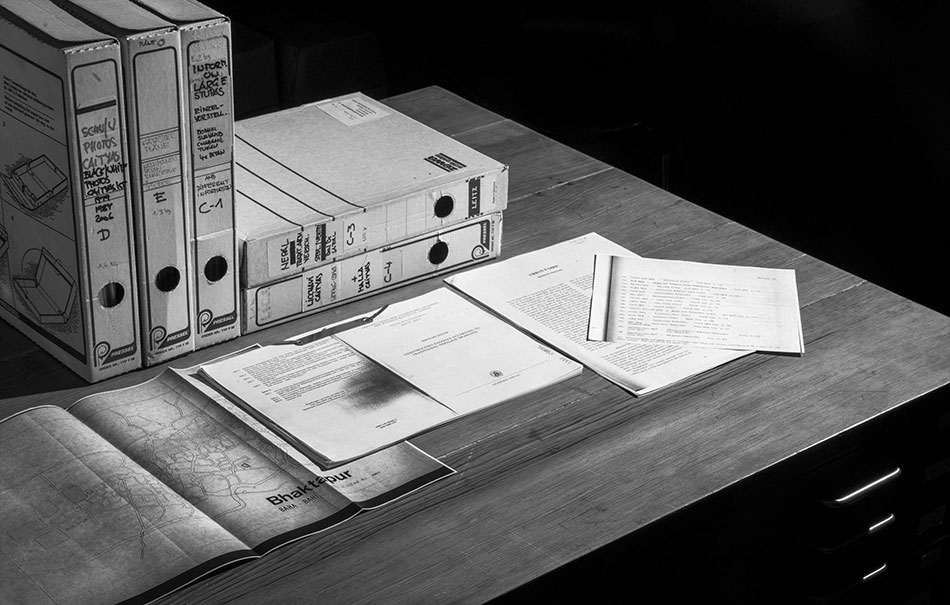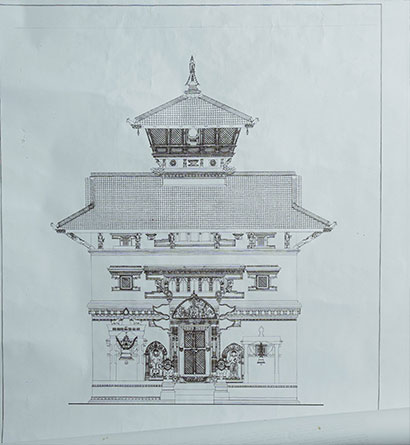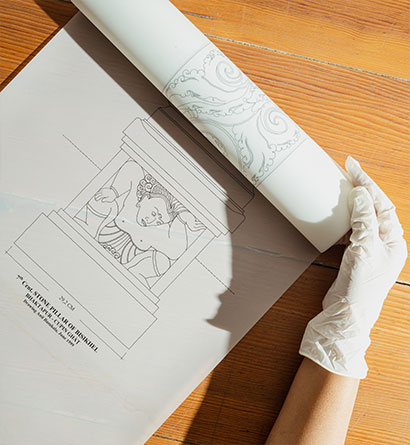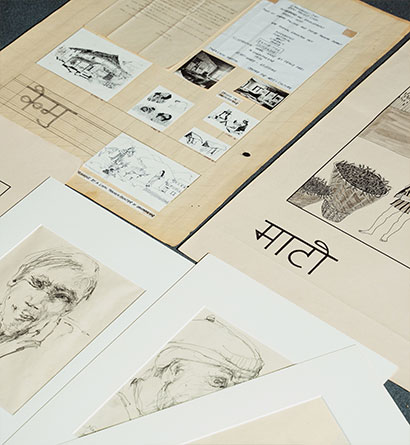
Nepal Architecture Archive is a unique repository of research works carried out by Nepal’s expatriate community during the second half of the twentieth century.
When Nepal opened to the outside world in the 50s, it marked an era of transition in our history. Once a forbidden Kingdom, it was now a preferred destination for scholars, researchers, individuals, and travelers. The country especially witnessed a considerable flow of trekkers, photographers, and foreign research projects supporting anthropologists, ecologists, architects, and alike. Untouched by modernity, Nepal was Painite of gems – a rare found in its purest form. In the following decades, it would welcome all the possibilities and changes that came with the arrival of visitors and researchers from around the world. From the 1950s to the early 2000s, Nepal was documented unprecedentedly. The documentation primarily involved Nepal’s cultural and built heritage, the Himalayas, flora and fauna, social and cultural dynamics, indigenous communities, material culture, and lifestyle. Our collection traverses a multitude of such contexts.
While studying and documenting the architectural heritage of Nepal, many researchers were fascinated by the dimensions of research it unplugged – thus wrapping their interest in the community’s way of life, culture, traditions, and social system. While architecture is an anchor point, our collection covers a broader social, cultural, and geographical context. At the same time, these collections capture the grounded reality and changing dynamics of contemporary Nepal. They portray Nepal in its varying dispositions in reference to time and perspectives. Most importantly, they are a record of Nepal’s recent history.
At the dawn of the 21st century, most researchers retired to their home countries, taking their lifelong works with them to lie unattended in attics across the world. Scholars and researchers are worried about the future of their lifelong work. In parallel, the patrons of Nepali heritage were concerned about their scholarly heritage. Recognizing their value and significance for future generations, the Foundation began retrieving and collecting them, creating one of the most extensive collections on Nepal’s intangible and built heritage.
Today, the scope of our collection is also expanding. We encourage, support, and collect documentation and research from Nepali scholars and researchers.



Our collection primarily consists of drawings and sketches from different research and documentation projects in Nepal between 1960 and 2020. Our 10,000+ architectural drawings include a few that span geographies and connect us with the architectural heritage in India, Tibet, Thailand, Myanmar, Mongolia, Cambodia, and Turkey.
Among the originals are Danish architects’ drawings of settlements in Bungamati (1969), Wolfgang Korn’s detailed drawings of Kasthamandapa (1970), Niels Gutschow’s drawing of the shape of Svayambunath (1972), Konstanty Gutschow’s plans and drawings of Budhanilkantha (1973), Johnannes Cramer’s pencil drawing of Hanuman Ghat in Bhaktapur with information (1973), Surendra Joshi’s sectional drawing of Nuvakot Darbar (1984), Austrian architects’ drawings of settlements in Ghyaru, Manang (1989), Reinhard Herdick’s sectional drawings of Baghbhairav (1990), Robert Powell’s sketch of Vambaha in Patan (1993), Warner Durth’s ink drawing of Keshav Narayana Chowk in Patan Durbar Square (1991), Peter Lorincz’s pen drawings of Patan (1991), Gotz Hagmuller’s pencil drawings of Patan Durbar (1990s), John Harrison’s drawings of Tibetan temples and vernacular architecture in Mustang (1990s), Klaus Kette’s sketches of settlements in lower and upper Mustang (1990s), Andreas Brandt’s colour pencil site section of Budu in Mugu (2006), and Bijay Basukala’s drawing of the southern portal of Krishna temple in Bhaktapur Durbar Square (2014-2016).
We also have original drawings for book projects, such as Water Conduits in the Kathmandu Valley (published 1995), Nepal Mandala-The Cultural Study of the Kathmandu Valley, Volume 2: Plates (1998), The Traditional Newar Architecture of the Kathmandu Valley: The Sikharas (2014), Towers in Stone (2014), The Traditional Newar Architecture of the Kathmandu Valley: The Stupas and the Chaityas (2015), The Portals in Newar Architecture (2016), The Traditional Architecture of the Kathmandu Valley (2017), Thimi Survey (2018), and The Sky Face (2019).
The highlight of our digital collection remains Rajmansingh Chitrakar’s sketches of Kathmandu, Bhaktapur and Patan (1844). For prints and reproductions, we have Surendra Joshi’s drawing of Pashupatinath printed on cartilage (1987), Wolfgang Korn and Auer Gerald’s drawings of Pujari Math in Bhaktapur printed in ammonia sheets (1971), Robert Powell’s printed drawings of Ladakh (1975), printed masterplan on ammonia sheet for the development of Lumbini (1977), among many others.
Most drawings in our collection are parts of projects by the German Research Council, German Technical Cooperations, Nepal Research Programme, Kathmandu Valley Preservation Trust, and UNESCO.



Our 50,000+ photographic collection includes slides, negatives, analog prints, and digital images.
In 1962, Peace Corps volunteers began their development projects in Nepal, resulting in substantial photographic documentation of different geographical areas, communities, cultures, and lifestyles. Our digital collection is enriched with the works of Doug Hall, Jim Coleman, Larry Daloz, Anne Stinson Pollitzer, Chris Walsh, Don Messerschmidt, Janet Asiain, Gregg Smith, and 114 other volunteers. A few thousand digital images are from Rene Tielenburg, who has documented Nepal for over 50 decades.
Among our extensive slides and negative collections are the works by Reinhard Herdick in Kirtipur (the 1980s), Ed Van Der Kooy in Kathmandu (1978), Annapurna (1978), Manang (1979), Langtang (1980), and Nepal (1982), Niels Gutschow in Kathmandu Valley (1972), Boudhanath (1992), Swayambhunath, Bhaktapur, Patan, and Bungamati, Wolfgang Korn in Patan, Kathmandu, Bhaktapur (1970s), and Mette Using in Boudhanath (the 1970s).
Analog prints include monochromes from Rukum(1987), Humla (1990), and Karnali(1990) by Niels Gutschow, Manang (1989) by Austrian architects, Mustang (1990s) by John Harrison, Boudhanath and Taragaon (1972-1974) by Katou Fumio, and others. Most photo prints are parts of research and documentation projects like the Bungamati Survey (1969), Mugu Chorten (1986-1998), Svayambhu Conservation Masterplan (1991-1993), Patan Conservation and Development Project (1991-1994), Chorten Tongdrol Chenmo (1999), Kathmandu Durbar Square Initiative (2000), and Buddhist Kathmandu - Itumbaha Initiative (the early 2000s).



Between the late 1960s and 2000, many heritage-related projects and surveys were supported and led by the German Embassy, German Research Council, German Technical Cooperation, Nepal Research Programme, Kathmandu Valley Preservation Trust, and UNESCO. The files and documents for significant projects such as the Bungamati Project (1968-1969), Restoration of Nuvakot and Gorkha Darbar (1980-1986), Nepal-German High Mountain Archeology Project (1980-1988), Restoration of Cyasilin Mandap (1987-1989), Patan Conservation Project (1989-1994), Svayambunath Conservation Master Plan (1990-1992), Kathmandu Darbar Square Initiative (early 2000), Buddhist Kathmandu - Itumbaha Initiative (2002-2005), and Reinhard Herdick’s extensive research on Kirtipur (1980s) are in our repository. Other projects in our collection are Hyatt Regency Kathmandu (1999) and Taragaon Project (2009-2014).
We also have a couple of reports on the Pujari Math Project (1971-1972), Kathmandu Valley Town Development Project (1976), Bhaktapur Development Project (1977-1983), UNESCO Nepal Conservation Activities (1985-2000), Urban Development through Local Efforts (1992-1993), International Centre for Integrated Mountain Development - Design Competition (2001), and Pashupati Master Plan Workshop Series (2017).
Some important survey documents in our care are the Bungamati Survey (1969), Bhaktapur Survey (1974), Chaitya Survey (1987), Mugu: An Architectural Survey of the Village of Kimri (1988), Chimang Survey (2016), Taka Survey (2018), and Thabang Survey (2018).



We maintain a research library with over 1500 resources, including books, journals, research documents, reports, maps, surveys, references, and bibliographies.
The oldest book in our collection is an illustrated hard-cover journal by L. Band, “Globus, Vol V,” published in 1886. Drafted in German, it focuses on regional and ethnographic studies and contains images and articles on Nepal. Dr Kurt Boeck’s “Durch Indien ins verschlossene Land Nepal” (1903) is another gem with images of Nepal in its most natural setting during the end of the nineteenth century. Other rare collections are Erwim Drinneberg’s travel book with images, “Von Ceylon zum Himalaja” (1926), Dr. Kurt Boek’s collection of poems and photographs from the Himalayas, “Himalaya: Lieder und Bilder” (1927), Paul Bauer’s “Im Kampf um den Himalaja” (1931) with texts and photographs of the author’s journey from Munich to Kanchenjunga in Nepal, Mulk Raj Anand’s illustrative book of “Kama Kala: Some Notes on the Philosophical Basis of Hindu Erotic Sculptures” (1958), and Michael and Luzzi Wolgensinger’s photo book with text by Arthur Durst, “Nepal” (1966), showing Nepal in its diverse facets from the Terai belt to the Himalayas.
Among our comprehensive collection of books and references are Carl Pruscha’s “Kathmandu Valley: The Preservation of Physical Environment and Cultural Heritage, A Protective Inventory, Vol. I and II” (1975), encompassing the inventory monuments, monument sites, monument zones and preservation districts in the valley, Wolfgang Korn’s “The Traditional Architecture of the Kathmandu Valley” (1979), combining his study and research for several years on architecture of religious, public and private buildings, Gutschow, Kolver and Shresthacharya’s “Newar Towns and Buildings: An Illustrated Dictionary Newari-English” (1984), Reinhard Herdick’s “Kirtipur: Stadtgestalt, Prinzipien der Raumordnung und gesellschaftliche Funktionen einer Newar-Stadt” (1988), a detailed research on Kirtipur and its spatial arrangement, Raimund O.A. Becker-Ritterspach’s “Water Conduits in the Kathmandu Valley” (1995), sketching the water architecture of the valley and exploring the construction and design of water conduits in urban space and landscape, and Niels Gutschow’s “The Nepalese Caitya: 1500 Years of Buddhist and Votive Architecture in the Kathmandu Valley” (1997), an inventory of chaityas in Kathmandu Valley exploring the development, types and structures of chaityas, their iconographies and related rituals and myths, Robert Powell’s “Earth Door Sky Door: Paintings of Mustang” (1999), a collection of architectural paintings in watercolor from the Himalayan Kingdom of Mustang, Krauskopff, Meyer, and Panjiyar’s “The Kings of Nepal & the Tharu of the Tarai: Fifty Royal Documents issued from 1726 to 1971” (2000), bringing to light the history and roles of Tharu in transforming the jungles in Tarai into a breadbasket of Nepal and their contributions to the royal court and its affairs, Mary Shepherd Slusser’s “The Antiquity of Nepalese Wood Carving: A Reassessment” (2009), introducing the traditional Newar-style architecture, with a special focus on struts, and Niels Gutschow’s “Architecture of the Newars: A History of Building Typologies and Details in Nepal, Vol. I, II, & III” (2011), a documentation of monuments and architecture of three different periods: the early period, the Malla period, and the modern period.



Although architectural drawings, surveys, and projects remain our focus, our collection comprises diverse materials. We have maps of Kathmandu Valley (the 1970s) by Erwin Schneider, Illustrations from Dolakaha (1976) by Franz Frei, maps for Bhaktapur traffic planning and land use plan (1973) by Niels Gutschow, Calligraphy by Klaus Kette, Carpet design drawings by Tom Glenn, footage of ethnographic research on Raji Shaman (1970), Udhas (1968), Raute (1969), Kumhale (1968), and Kusunda (1968-69) by John Reinhard, videotape collection of Nepal (1978-1980) by Ed Van Der Kooy, a set of documentary films on Shamans (1980s) by Michael Oppitz, beta tapes on heritage sites and rituals (1970s to 1990s) by Niels Gutschow, creative mockup design of a school (2004-2006) by Benedetta Tagaliabue, catalogue for the opening of the wood carving museum of pujari math (1988/89) by Gotz Hagmuller and Niels Gutschow, original painting of a Tibetan girl (the late 1950s) by Lily Eversdyjk Smulders, photo albums portraying the political scenario in the 1990s by Barbara Adams, and posters and envelope designs by Robert Powell.
Other materials include book covers, wood structures and carvings, pots, floppy disks, vinyl, cassettes, journals, bibliographies, research papers, project proposals, correspondence, diary entries, certificates, budget sheets, magazines, newspapers, and postcards.